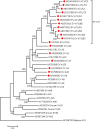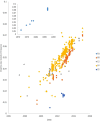A decade of sustained selection pressure on two surface sites of the VP1 protein of Enterovirus A71 suggests that immune evasion may be an indirect driver for virulence
- PMID: 30931960
- PMCID: PMC6443798
- DOI: 10.1038/s41598-019-41662-8
A decade of sustained selection pressure on two surface sites of the VP1 protein of Enterovirus A71 suggests that immune evasion may be an indirect driver for virulence
Abstract
Enterovirus A71 (EV-A71) is an emerging pathogen in the Enterovirus A species group. EV-A71 causes hand, foot and mouth disease (HFMD), with virulent variants exhibiting polio-like acute flaccid paralysis and other central nervous system manifestations. We analysed all enterovirus A71 complete genomes with collection dates from 2008 to mid-2018. All sub-genotypes exhibit a strong molecular clock with omega (dN/dS) suggesting strong purifying selection. In sub-genotypes B5 and C4, positive selection can be detected at two surface sites on the VP1 protein, also detected in positive selection studies performed prior to 2008. Toggling of a limited repertoire of amino acids at these positively selected residues over the last decade suggests that EV-A71 may be undergoing a sustained frequency-dependent selection process for immune evasion, raising issues for vaccine development. These same sites have also been previously implicated in virus-host binding and strain-associated severity of HFMD, suggesting that immune evasion may be an indirect driver for virulence (154 words).
Conflict of interest statement
The authors declare no competing interests.
Figures






Similar articles
-
Enterovirus A71 Containing Codon-Deoptimized VP1 and High-Fidelity Polymerase as Next-Generation Vaccine Candidate.J Virol. 2019 Jun 14;93(13):e02308-18. doi: 10.1128/JVI.02308-18. Print 2019 Jul 1. J Virol. 2019. PMID: 30996087 Free PMC article.
-
Virulence of Enterovirus A71 Fluctuates Depending on the Phylogenetic Clade Formed in the Epidemic Year and Epidemic Region.J Virol. 2021 Nov 9;95(23):e0151521. doi: 10.1128/JVI.01515-21. Epub 2021 Sep 15. J Virol. 2021. PMID: 34523967 Free PMC article.
-
Enterovirus A71: virulence, antigenicity, and genetic evolution over the years.J Biomed Sci. 2019 Oct 21;26(1):81. doi: 10.1186/s12929-019-0574-1. J Biomed Sci. 2019. PMID: 31630680 Free PMC article. Review.
-
Clinically isolated enterovirus A71 subgenogroup C4 strain with lethal pathogenicity in 14-day-old mice and the application as an EV-A71 mouse infection model.Antiviral Res. 2017 Jan;137:67-75. doi: 10.1016/j.antiviral.2016.11.008. Epub 2016 Nov 15. Antiviral Res. 2017. PMID: 27864074
-
Recent Progress in Innate Immune Responses to Enterovirus A71 and Viral Evasion Strategies.Int J Mol Sci. 2024 May 23;25(11):5688. doi: 10.3390/ijms25115688. Int J Mol Sci. 2024. PMID: 38891876 Free PMC article. Review.
Cited by
-
Unveiling of Evolution Pattern for HY12 Enterovirus Quasispecies and Pathogenicity Alteration.Viruses. 2021 Oct 28;13(11):2174. doi: 10.3390/v13112174. Viruses. 2021. PMID: 34834980 Free PMC article.
-
A tradeoff between enterovirus A71 particle stability and cell entry.Nat Commun. 2023 Nov 17;14(1):7450. doi: 10.1038/s41467-023-43029-0. Nat Commun. 2023. PMID: 37978288 Free PMC article.
References
-
- Yip CC, et al. Genetic characterization of EV71 isolates from 2004 to 2010 reveals predominance and persistent circulation of the newly proposed genotype D and recent emergence of a distinct lineage of subgenotype C2 in Hong Kong. Virol J. 2013;10:222. doi: 10.1186/1743-422X-10-222. - DOI - PMC - PubMed
Publication types
MeSH terms
Substances
LinkOut - more resources
Full Text Sources
Miscellaneous

